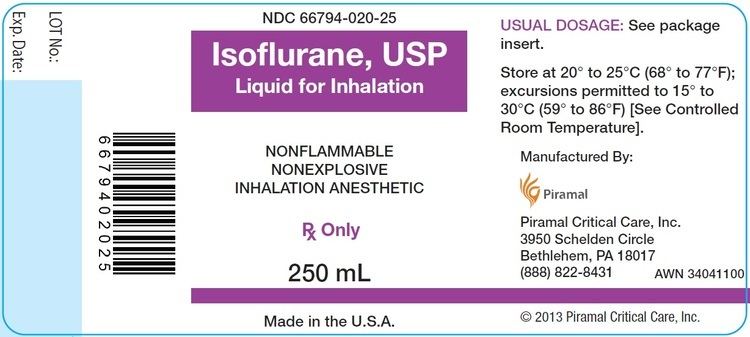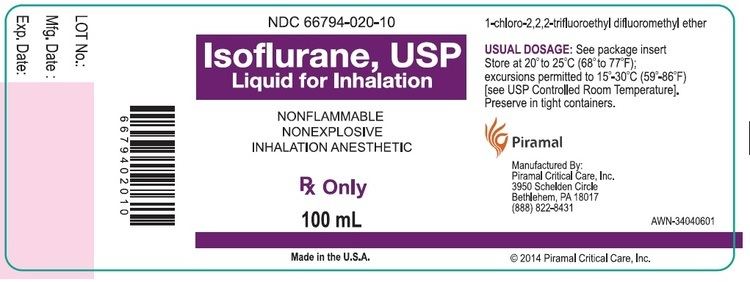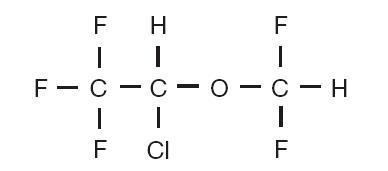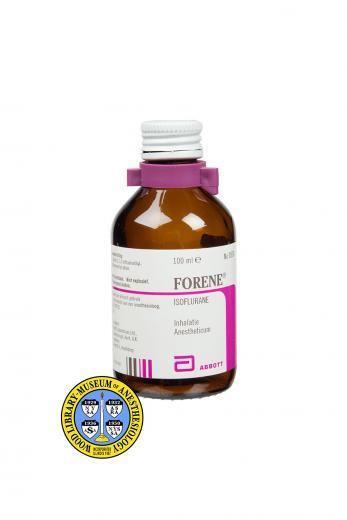Trade names Forane, others CAS Number 26675-46-7 CAS ID 26675-46-7 | Pregnancycategory C ATC code N01AB06 (WHO) Molar mass 184.5 g/mol | |
 | ||
AHFS/Drugs.com FDA Professional Drug Information | ||
Isoflurane, sold under the trade name Forane among others, is a general anesthetic. It can be used to start or maintain anesthesia. Often another medication, however, is used to start anesthesia due to airway irritation with isoflurane. It is used by inhalation.
Contents
- Medical uses
- Adverse effects
- Elderly
- Physical properties
- Mechanism of action
- History
- Environment
- Other animals
- References

Side effects include a decreased effort to breathe (respiratory depression), low blood pressure, and irregular heartbeat. Serious side effects may include malignant hyperthermia and high blood potassium. It should not be used in people with a history of malignant hyperthermia either in themselves or their family members. It is unknown if use during pregnancy is safe for the baby; however, use during a cesarean section appears to be okay. Isoflurane is in the halogenated ether family of medication.

Isoflurane was approved for medical use in the United States in 1979. It is on the World Health Organization's List of Essential Medicines, the most effective and safe medicines needed in a health system. The wholesale cost in the developing world is about 17.24 to 170.40 USD per 250 ml bottle.

Medical uses

Isoflurane is always administered in conjunction with air and/or pure oxygen. Often nitrous oxide is also used. Although its physical properties imply that anaesthesia can be induced more rapidly than with halothane, its pungency can irritate the respiratory system, negating this theoretical advantage conferred by its physical properties. It is usually used to maintain a state of general anesthesia that has been induced with another drug, such as thiopentone or propofol.
Adverse effects

Animal studies have raised safety concerns of certain general anesthetics, in particular ketamine and isoflurane in young children. The risk of neurodegeneration was increased in combination of these agents with nitrous oxide and benzodiazepines such as midazolam. Whether these concerns occur in humans is unclear.
Elderly

Concerns exist with regard to the relationship between administration of isoflurane and postoperative cognitive dysfunction (POCD), for which the elderly are especially vulnerable.

Biophysical studies using state-of-the-art NMR spectroscopy has provided molecular details of how inhaled anesthetics interact with three amino acid residues (G29, A30 and I31) of amyloid beta peptide and induce aggregation. This area is important as "some of the commonly used inhaled anesthetics may cause brain damage that accelerates the onset of Alzheimer’s disease".
Physical properties

It is a racemic mixture of (R)- and (S)-optical isomers. It vaporizes readily, but is a liquid at room temperature. It does not burn.
Mechanism of action
Similar to many general anesthetics, the exact mechanism of the action has not been clearly delineated. Isoflurane reduces pain sensitivity (analgesia) and relaxes muscles. Isoflurane likely binds to GABA, glutamate and glycine receptors, but has different effects on each receptor. It potentiates glycine receptor activity, which decreases motor function. It inhibits receptor activity in the NMDA glutamate receptor subtypes. Isoflurane inhibits conduction in activated potassium channels. Isoflurane also affects intracellular molecules. It activates calcium ATPase by increasing membrane fluidity. It binds to the D subunit of ATP synthase and NADH dehydrogenase.
General anaesthesia with isoflurane reduces plasma endocannabinoid AEA concentrations, and this could be a consequence of stress reduction after loss of consciousness.
History
Together with enflurane and halothane, it replaced the flammable ethers used in the pioneer days of surgery. Its name comes from being a structural isomer of enflurane, hence they have the same empirical formula.
Environment
The average lifetime of isoflurane in the atmosphere is 3.2 years, its global warming potential is 510 and the yearly emissions add up to 880 tons.
Other animals
Isoflurane is frequently used for veterinary anaesthesia.
